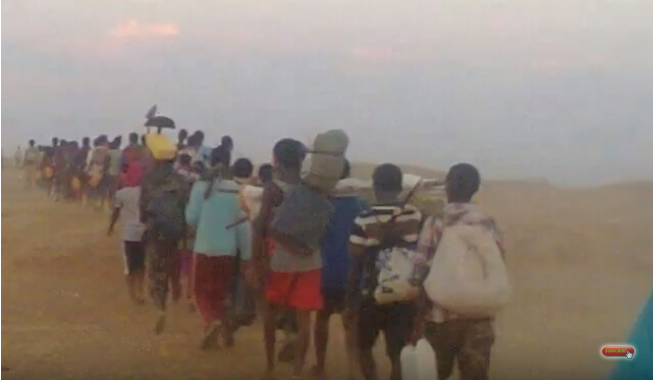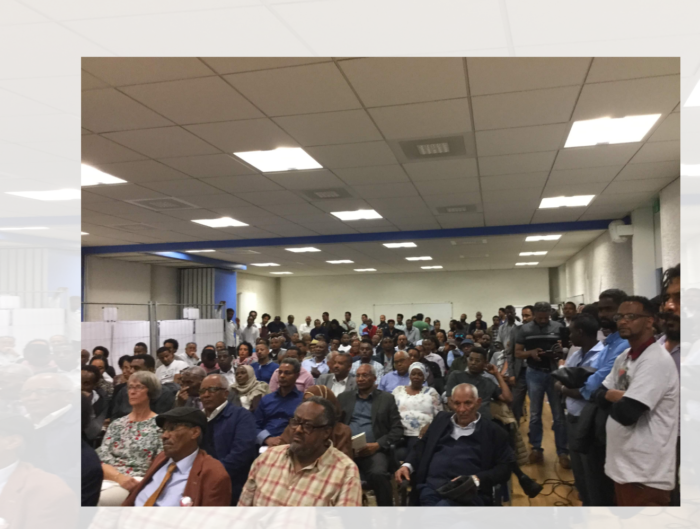Thinking of going to Eritrea and visiting tourist attractions like museums, historic sites and off-the-beaten-path destinations? Ask Sham Harif (@shamharif): he got you covered. This was his response to a certain Lilian who had such a question on Facebook. If you don’t like his answer, you can always reach out to Eritrea’s ruling party and get your “guided tour” so you can come back and be like the Amhara Mass Media Agency (“oh my goodness! The Minister of Justice pays for her own cab fare on weekends!”), BBC’s Mary Harper (“I was told….”) or the Atlantic Council’s Bronwyn Bruton (“they are quietly releasing prisoners and quietly writing a constitution….”) and repeat the government’s talking points.
________________________
Check out Al Diia Al Islamia school in Akria [overtaken by government, its director arrested and now dead], and the office of the Orthodox Patriarch Abune Antonios [arrested], there are some Catholic clinics in Deqemhare and other town where they provide help to the destitute [update: they are taken over by the government.]
If you want some architectural sightseeing, there’s the old Italian building where the only University used to be [update: it is closed] near the stadium in Asmara. If you follow the road leading to Karcheli [prison] where you may still find prisoners of all faiths, you might be able to spot where the bullets hit the wall as soldiers shot against civilians in 2016. For fresher wall chippings from bullets, you can of course stroll through commishtato, near the Ministry of Education.
For a trip on the Western side of the country I would strongly recommend Sawa High School where you can still see militarised education.
Of course, Bisha Mines [Nevsun] are a mere ride from there: you will be able to see where the gold and copper money comes from (unfortunately, there isn’t much indication of where it goes to).
If for any reason you haven’t stopped by Adi Abeyto [video] on your way out, do have a visit when returning. The torture chambers in what used to be offices and warehouses are the stuff of legend. If you’re lucky and arrive at the right time you might even get a bowl of… red-ish liquid with stone-hard bread. It is customary to pay homage to the dead prisoners of 2005 who were shot as they tried to flee after they were forcibly and unlawfully detained.
On the Eastern side of the country, on your way to Massawa, you can find Embatkala where some famous political prisoners were jailed (think of it like visiting Robben Island in South Africa). Naturally, as you bend through Nefasit to reach this historical place you will have passed May Habar, where disabled liberation heroes were shot and killed in the early 90s. [video testimony of survivor]
Once you reach Massawa, you may find that it’s changed, depending on when you were there last, because the President, also chief architect, has demolished some old buildings. Don’t be surprised if you find the port full of Ethiopian ships.
If you would like to see some unusual landscape, a little south of Hirghigo, there’s Wia. I wouldn’t recommend you stray too much south of that, as you may bump into Emirati military bases from which planes depart to bomb and cause one of the worst famines in history in Yemen. [video of UAE military bases in Eritrea.] So let’s keep out of such unpleasantness.
If you go to the south of the country you could also see where the young heroes of the 2 year ‘border’ war died. [video] It’s a sort of memorial place, except, it might be considered taboo to remember them as the president has declared we didn’t incur any losses.
Please do remember to go to Adi Halo, appearances may deceive but locals (I mean internet locals of course) say miraculous things happen there thanks to a dynastical leader.
If you can get some off-road rides you might also go to Asha Golgol [just 10 km south of Asmara] where, despite the sanctions, the same leader has managed to buy military helicopters and other arms using his bogus aviation companies and other means from abroad. It may be difficult to enter such sites, though.
You may have heard of the opera house Asmara Theatre frequented by poets and artists, despite their work being heavily censored. Behind it, across the street from Ibrahim Sultan High School, there’s a charming villa within which our constitution [update: shelved then killed] was written.
Then, drive down the main road and after a few minutes you will reach Biet Gergish, where the only zoo is, well, kind of empty of animals. However, there are plenty of forcibly conscripted soldiers around even if they’re hard to spot. For example, you may see some training grounds there where the elderly who have been forced to take arms again go to do some healthy military marching (a sort of relaxing tai chi in the park for the senior citizens).
As you peek through the woods and see the early morning clouds rise, you might be tempted to try a day out in Ghinda. However, you may not know it as you drive through Durfo, but the tops of the hills through which you drive above winding precipices are full of soldiers kept isolated from their society. Don’t worry, I don’t think they’ll harm the likes of tourists, only the locals they’re ordered to pounce upon.
A delightful excavation is happening in the Gulf of Zula, in the ancient town of Adulis. It’s mainly Italians leading the work though, as Eritrean academics have not had the chance to freely explore and study in their own country. Not to worry: you won’t be lonely, you’ll find your kin doing the digging there.
It’s understandable if you want to just jump on a boat since you’re on the lovely bay and try to see the Dahlak Islands.[video] Fantastic tourist attractions. Mind you, if you get bored of the beautiful coral reefs, you might get a better ‘Robben Island’ experience here, as you might want to check out the scorching underground prisons where deported Eritreans from Malta were tortured and killed in 2002.
The tourist pamphlets might also advertise Nakfa, and I strongly suggest you visit. The trenches running hundreds of miles are astounding, and the land once completely barren due to the heavy bombardment during the independence struggle is now recovering and some of the flora and fauna are returning. No need to concern yourself with the legacy of those who died there or the fates of their families, as the sacrifice of these valiant men and women to ensure justice and democracy has… well apparently we didn’t incur a loss on that as well. [video]
Once back in Asmara and in an urban setting, please don’t be shocked by the mentally ill people in the streets if you haven’t noticed them before. St Mary’s Psychiatric Hospital Asmara has been without its only psychiatrist, Rev Dr Futsum Gebrenegus, who has been in prison since 2004.
If you prefer a view from a hill, try climbing the small winding road to Forto, where wedi-Ali and his colleagues tried to remove the dictatorship. You will also get a good view of Orota Hospital, which you don’t need to (and should hope not to) visit due to its poor amenities and services.
If, inspired by the view from the hill, you decide to walk up the hill towards the president’s office [a walking distance from the Bisha Mining Center Office, wink], you will pass near one of the most well-known buildings to locals: the Office of Secret Services. These are just the offices, mind you; their presence is pervasive, even if, thus far, you may not have noticed them.
Less infamous, but more known perhaps, is the immigration building within which many people get their fundamental human rights of movement and their civic right of holding a passport denied. Of course, if you saved some cash from your Dahlak holidays, you can slip some to the right person and might be able to get a visa.
Posting originally appeared in Sham Harif’s FB page. Reprinted with permission. Notes in brackets added by editor to help those who are slower on the uptake. On Twitter, you can follow Sham Harif @shamharif.





Leave A Reply